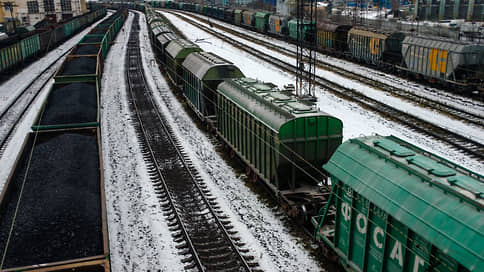Loading by rail decreased by 0.2% at the end of 2023
[ad_1]

December, contrary to the expectations of Russian Railways, did not allow the company to catch up with the loading gap from the plan for 2023. At the end of the year, it decreased by 0.2% by 2022 and was below the target by 0.9%, including against the backdrop of restrictions on the supply of petroleum products for export in the fourth quarter, problems with locomotives and large-scale construction. At the same time, the monopoly remains optimistic about 2024, in which it expects loading to increase by 2.7%.
Loading on the Russian Railways network at the end of 2023 could not show the expected growth of 0.8%. It amounted to 1232.3 million tons, which is 0.2% less than a year earlier. Going to fall in October (see “Kommersant” dated November 1 And December 1, 2023), loading, which grew evenly at a slow pace in the first months of the year, was unable to recover in December. At the end of the last month, it decreased by 1.9%, to 100.7 million tons.
In December, shipments of industrial raw materials (by 45.6%), grain (by 25.4%), scrap ferrous metals (by 21.4%) and coke (by 19.5%) increased noticeably. At the same time, a serious lag remained in the most massive cargo. Thus, coal transportation decreased by 6.4%, to 29.2 million tons; such a lag is typical for the entire fourth quarter – by an average of 6.8% per month. Transportation of oil cargo, which on average for the year showed a lag from last year’s figures, decreased by 2.6%; transportation of construction cargo also fell sharply (by 21.8%), on the contrary, at the beginning of the year, which was one of the main drivers of growth in loading.
0.2 percent
amounted to a decrease in railway loading in 2023
As JSC Russian Railways explains, the slowdown in loading dynamics in the fourth quarter is due to continued restrictions on the export supply of petroleum products, a decrease in the transportation of construction cargo due to the completion of a number of large infrastructure projects in the central part of the country, the closure of a number of shipping enterprises for unscheduled repairs, and an increase in locomotive downtime. in repairs from service companies and large-scale construction and repair work deployed on the network.
At the end of the whole year, the undisputed leader in growth rates in share terms was grain transportation, which increased by 37.1%.
Transportation of fertilizers increased by 5.4%, a noticeable increase was observed in shipments of metallurgical cargo – ferrous metals, their scrap, coke – with a decrease in transportation of iron and non-ferrous ore. Transportation of other cargo, which includes container cargo, increased by 4.9%. The main cargoes—coal and petroleum products—ended the year with volume declines of 1.2% and 2.7%, respectively.
The 2024 plan assumes reaching 1265.4 million tons, which is 2.7% higher than the actual result in 2023.
The company does not say whether they plan to revise it, but note that in 2023 and in previous years, a lot of work has been done to develop the capacity and carrying capacity of the infrastructure. “There is still a high demand for transportation, especially in the eastern direction,” Russian Railways OJSC explained to Kommersant. “Alternative routes, including along the North-South corridor, and the start of transportation to the port of Lavna also make a contribution.” ” Therefore, the company is optimistic about the prospects for increasing loading volumes.
A Kommersant source in the market notes that in December, loading lagged behind by 1.9%; based on the results of 22 days of December, the gap with last year was higher – 2.2%. This means, he says, that in the last days of December increased volumes were accepted for transportation, therefore, in January there will be further difficulties with the passage of wagons, increased volumes of train abandonment and an increase in the actual turnover of wagons.
It would be correct for Russian Railways to broadcast in advance that the loading plan has been revised, since the market, especially in recent months, expects more accurate forecasting from the company, believes the head of Infoline-Analytics, Mikhail Burmistrov. In this case, the explanations would be quite understandable: there are problems both on the side of Russian Railways and those associated with shippers, and loading was also noticeably affected by the ban on the export of petroleum products and earlier problems with liquid cargo. The loading forecast for 2024, according to Mr. Burmistrov, looks very ambitious, but not unattainable if the problems that emerged this year are resolved. We are talking about increasing the efficiency of interaction with shippers within the framework of a dynamic model of infrastructure loading with a focus on route shipments for export, improving the situation with the technical readiness of traction stock (where, according to the expert, there has been progress) and with locomotive crews (where, on the contrary, there is a shortage of personnel only gets stronger). A separate factor is the growth of terrorist risks, where, according to the expert, the situation will worsen, and there is a question of how much the significant increase in security costs agreed upon by Russian Railways will help.
[ad_2]
Source link





